The absence of the producers in a food web
VerifiedAdded on 2022/09/14
|9
|2251
|20
AI Summary
Contribute Materials
Your contribution can guide someone’s learning journey. Share your
documents today.
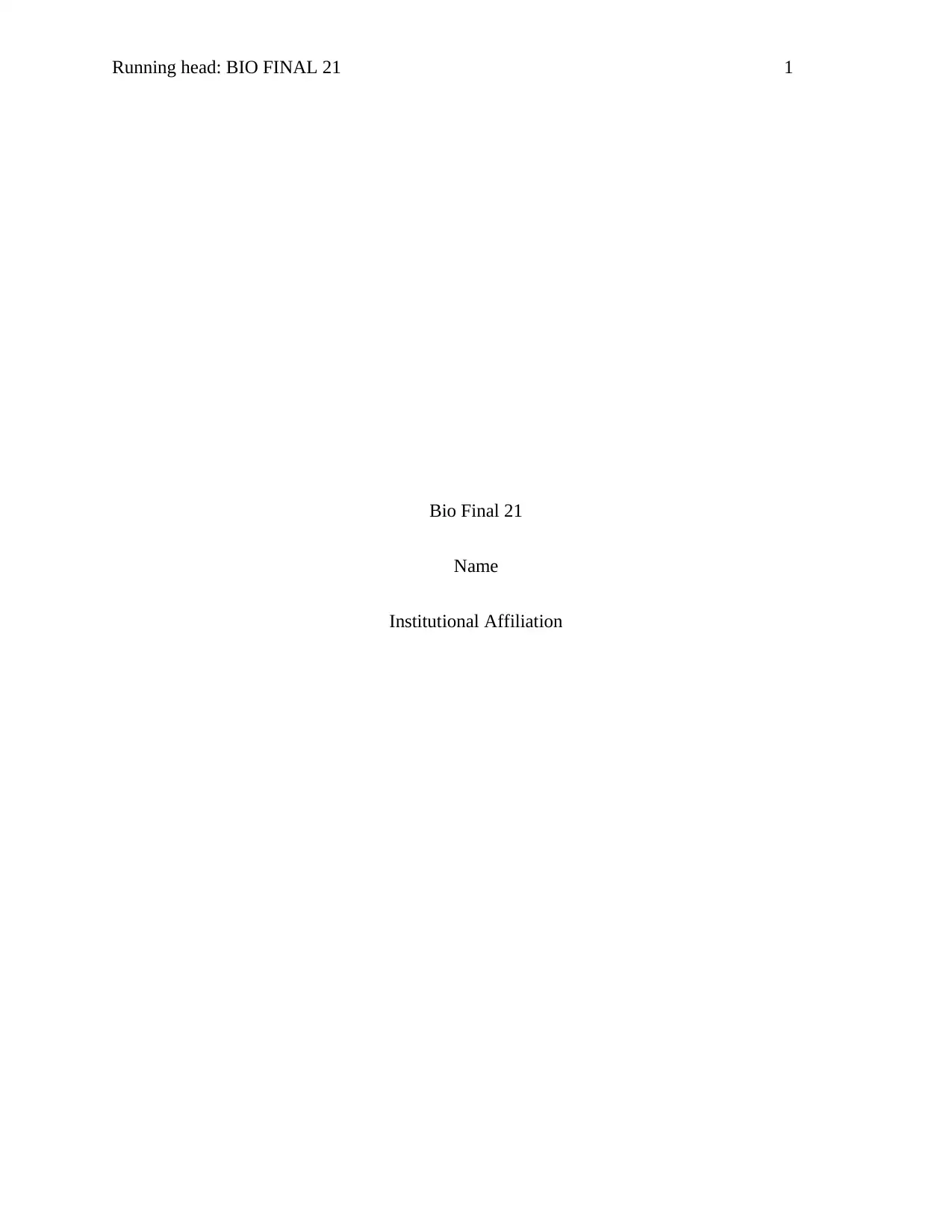
Running head: BIO FINAL 21 1
Bio Final 21
Name
Institutional Affiliation
Bio Final 21
Name
Institutional Affiliation
Secure Best Marks with AI Grader
Need help grading? Try our AI Grader for instant feedback on your assignments.
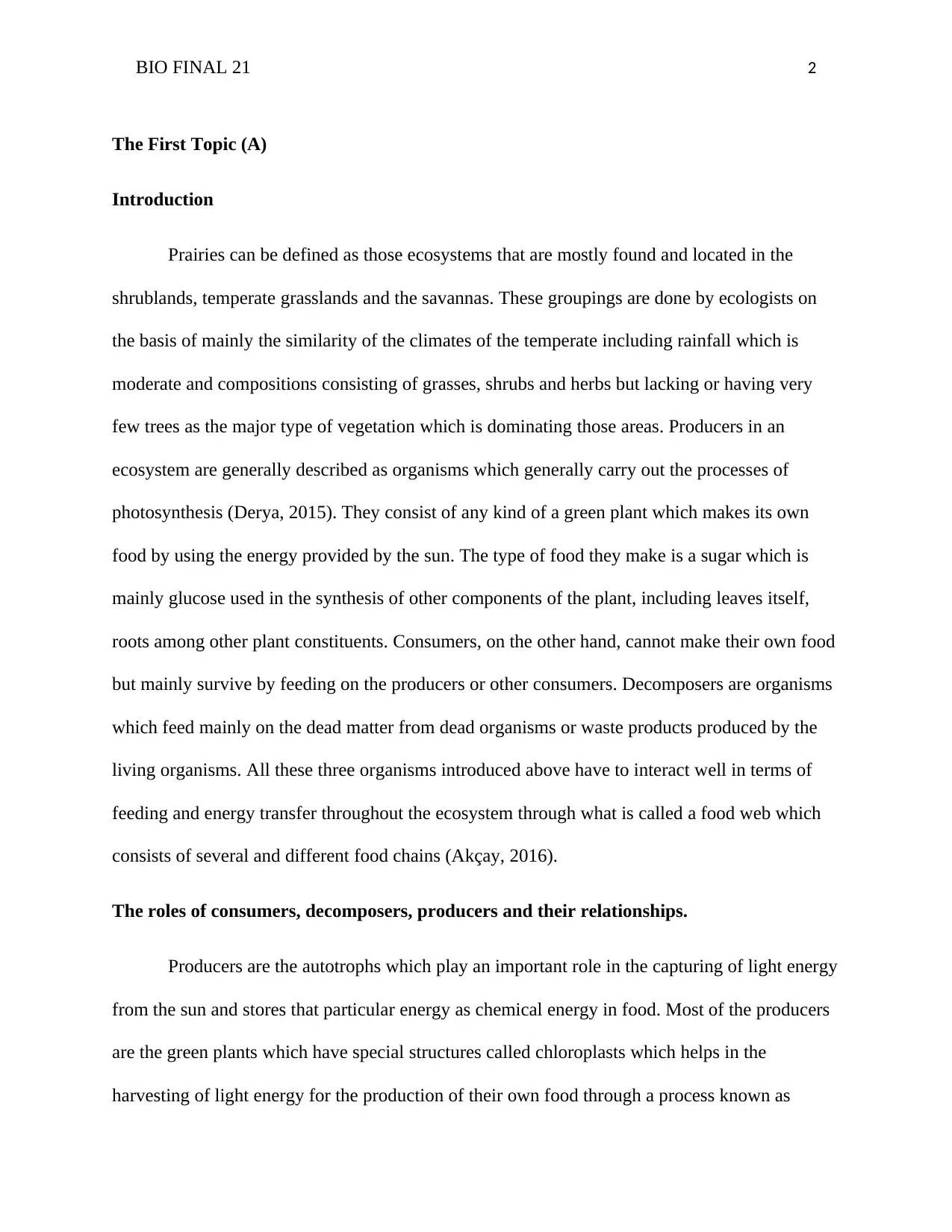
BIO FINAL 21 2
The First Topic (A)
Introduction
Prairies can be defined as those ecosystems that are mostly found and located in the
shrublands, temperate grasslands and the savannas. These groupings are done by ecologists on
the basis of mainly the similarity of the climates of the temperate including rainfall which is
moderate and compositions consisting of grasses, shrubs and herbs but lacking or having very
few trees as the major type of vegetation which is dominating those areas. Producers in an
ecosystem are generally described as organisms which generally carry out the processes of
photosynthesis (Derya, 2015). They consist of any kind of a green plant which makes its own
food by using the energy provided by the sun. The type of food they make is a sugar which is
mainly glucose used in the synthesis of other components of the plant, including leaves itself,
roots among other plant constituents. Consumers, on the other hand, cannot make their own food
but mainly survive by feeding on the producers or other consumers. Decomposers are organisms
which feed mainly on the dead matter from dead organisms or waste products produced by the
living organisms. All these three organisms introduced above have to interact well in terms of
feeding and energy transfer throughout the ecosystem through what is called a food web which
consists of several and different food chains (Akçay, 2016).
The roles of consumers, decomposers, producers and their relationships.
Producers are the autotrophs which play an important role in the capturing of light energy
from the sun and stores that particular energy as chemical energy in food. Most of the producers
are the green plants which have special structures called chloroplasts which helps in the
harvesting of light energy for the production of their own food through a process known as
The First Topic (A)
Introduction
Prairies can be defined as those ecosystems that are mostly found and located in the
shrublands, temperate grasslands and the savannas. These groupings are done by ecologists on
the basis of mainly the similarity of the climates of the temperate including rainfall which is
moderate and compositions consisting of grasses, shrubs and herbs but lacking or having very
few trees as the major type of vegetation which is dominating those areas. Producers in an
ecosystem are generally described as organisms which generally carry out the processes of
photosynthesis (Derya, 2015). They consist of any kind of a green plant which makes its own
food by using the energy provided by the sun. The type of food they make is a sugar which is
mainly glucose used in the synthesis of other components of the plant, including leaves itself,
roots among other plant constituents. Consumers, on the other hand, cannot make their own food
but mainly survive by feeding on the producers or other consumers. Decomposers are organisms
which feed mainly on the dead matter from dead organisms or waste products produced by the
living organisms. All these three organisms introduced above have to interact well in terms of
feeding and energy transfer throughout the ecosystem through what is called a food web which
consists of several and different food chains (Akçay, 2016).
The roles of consumers, decomposers, producers and their relationships.
Producers are the autotrophs which play an important role in the capturing of light energy
from the sun and stores that particular energy as chemical energy in food. Most of the producers
are the green plants which have special structures called chloroplasts which helps in the
harvesting of light energy for the production of their own food through a process known as
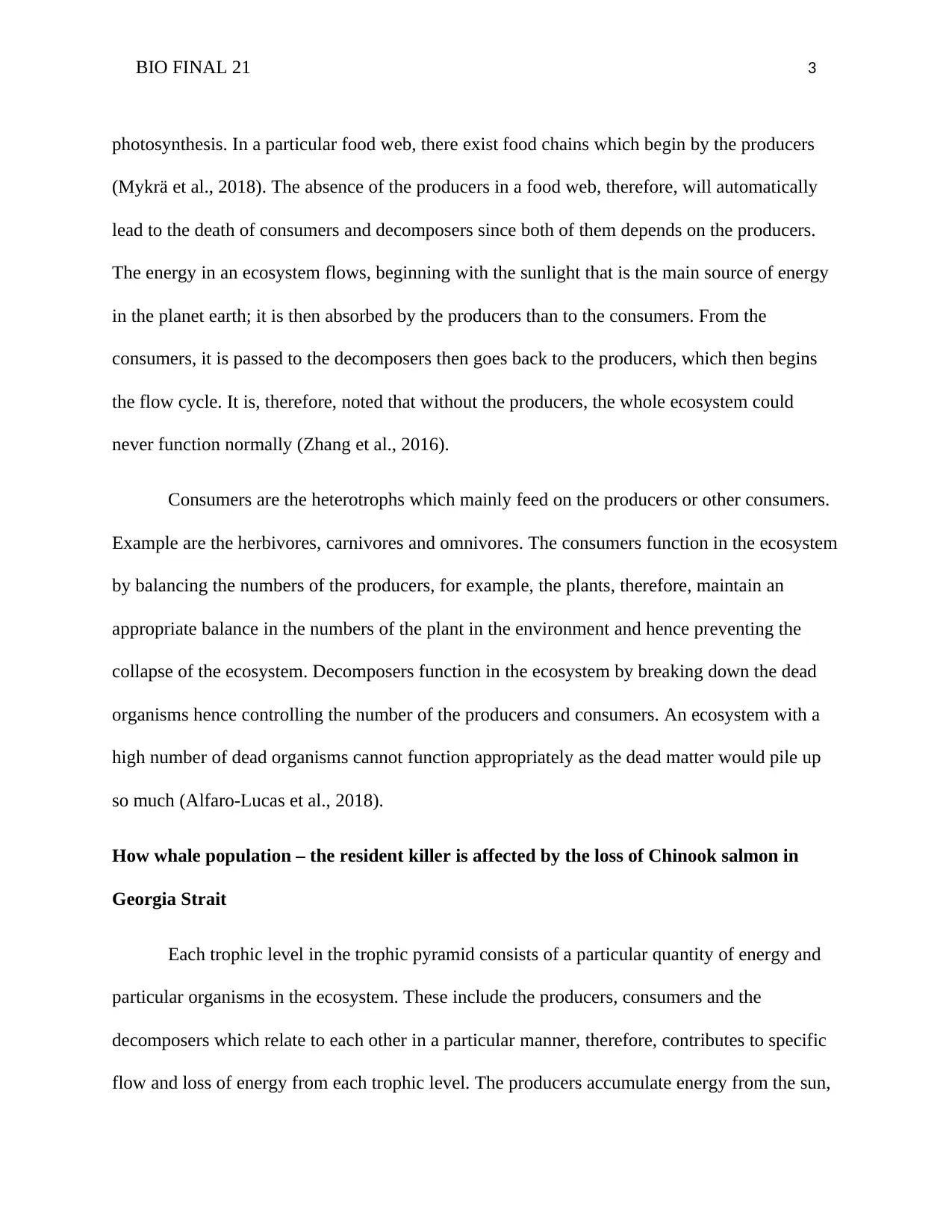
BIO FINAL 21 3
photosynthesis. In a particular food web, there exist food chains which begin by the producers
(Mykrä et al., 2018). The absence of the producers in a food web, therefore, will automatically
lead to the death of consumers and decomposers since both of them depends on the producers.
The energy in an ecosystem flows, beginning with the sunlight that is the main source of energy
in the planet earth; it is then absorbed by the producers than to the consumers. From the
consumers, it is passed to the decomposers then goes back to the producers, which then begins
the flow cycle. It is, therefore, noted that without the producers, the whole ecosystem could
never function normally (Zhang et al., 2016).
Consumers are the heterotrophs which mainly feed on the producers or other consumers.
Example are the herbivores, carnivores and omnivores. The consumers function in the ecosystem
by balancing the numbers of the producers, for example, the plants, therefore, maintain an
appropriate balance in the numbers of the plant in the environment and hence preventing the
collapse of the ecosystem. Decomposers function in the ecosystem by breaking down the dead
organisms hence controlling the number of the producers and consumers. An ecosystem with a
high number of dead organisms cannot function appropriately as the dead matter would pile up
so much (Alfaro-Lucas et al., 2018).
How whale population – the resident killer is affected by the loss of Chinook salmon in
Georgia Strait
Each trophic level in the trophic pyramid consists of a particular quantity of energy and
particular organisms in the ecosystem. These include the producers, consumers and the
decomposers which relate to each other in a particular manner, therefore, contributes to specific
flow and loss of energy from each trophic level. The producers accumulate energy from the sun,
photosynthesis. In a particular food web, there exist food chains which begin by the producers
(Mykrä et al., 2018). The absence of the producers in a food web, therefore, will automatically
lead to the death of consumers and decomposers since both of them depends on the producers.
The energy in an ecosystem flows, beginning with the sunlight that is the main source of energy
in the planet earth; it is then absorbed by the producers than to the consumers. From the
consumers, it is passed to the decomposers then goes back to the producers, which then begins
the flow cycle. It is, therefore, noted that without the producers, the whole ecosystem could
never function normally (Zhang et al., 2016).
Consumers are the heterotrophs which mainly feed on the producers or other consumers.
Example are the herbivores, carnivores and omnivores. The consumers function in the ecosystem
by balancing the numbers of the producers, for example, the plants, therefore, maintain an
appropriate balance in the numbers of the plant in the environment and hence preventing the
collapse of the ecosystem. Decomposers function in the ecosystem by breaking down the dead
organisms hence controlling the number of the producers and consumers. An ecosystem with a
high number of dead organisms cannot function appropriately as the dead matter would pile up
so much (Alfaro-Lucas et al., 2018).
How whale population – the resident killer is affected by the loss of Chinook salmon in
Georgia Strait
Each trophic level in the trophic pyramid consists of a particular quantity of energy and
particular organisms in the ecosystem. These include the producers, consumers and the
decomposers which relate to each other in a particular manner, therefore, contributes to specific
flow and loss of energy from each trophic level. The producers accumulate energy from the sun,
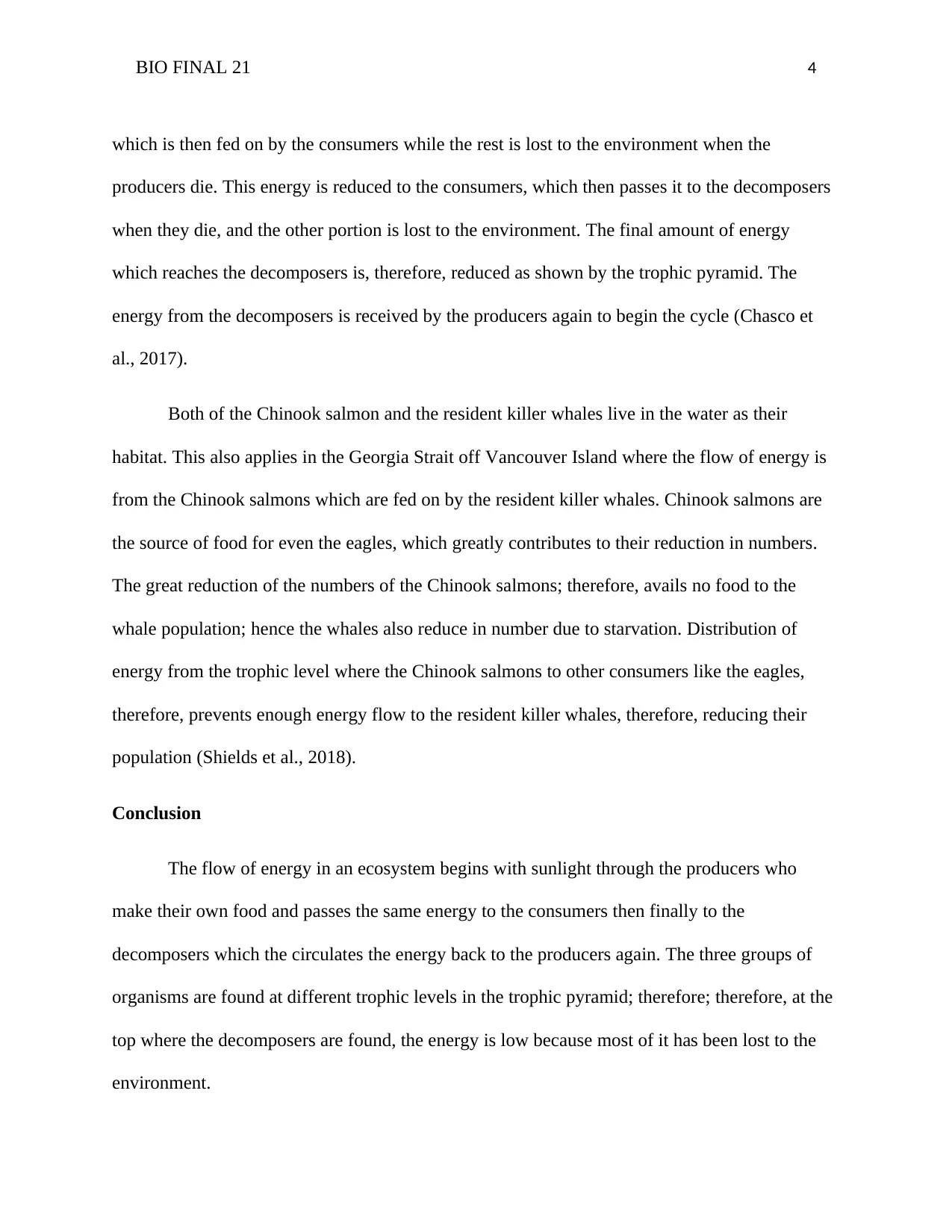
BIO FINAL 21 4
which is then fed on by the consumers while the rest is lost to the environment when the
producers die. This energy is reduced to the consumers, which then passes it to the decomposers
when they die, and the other portion is lost to the environment. The final amount of energy
which reaches the decomposers is, therefore, reduced as shown by the trophic pyramid. The
energy from the decomposers is received by the producers again to begin the cycle (Chasco et
al., 2017).
Both of the Chinook salmon and the resident killer whales live in the water as their
habitat. This also applies in the Georgia Strait off Vancouver Island where the flow of energy is
from the Chinook salmons which are fed on by the resident killer whales. Chinook salmons are
the source of food for even the eagles, which greatly contributes to their reduction in numbers.
The great reduction of the numbers of the Chinook salmons; therefore, avails no food to the
whale population; hence the whales also reduce in number due to starvation. Distribution of
energy from the trophic level where the Chinook salmons to other consumers like the eagles,
therefore, prevents enough energy flow to the resident killer whales, therefore, reducing their
population (Shields et al., 2018).
Conclusion
The flow of energy in an ecosystem begins with sunlight through the producers who
make their own food and passes the same energy to the consumers then finally to the
decomposers which the circulates the energy back to the producers again. The three groups of
organisms are found at different trophic levels in the trophic pyramid; therefore; therefore, at the
top where the decomposers are found, the energy is low because most of it has been lost to the
environment.
which is then fed on by the consumers while the rest is lost to the environment when the
producers die. This energy is reduced to the consumers, which then passes it to the decomposers
when they die, and the other portion is lost to the environment. The final amount of energy
which reaches the decomposers is, therefore, reduced as shown by the trophic pyramid. The
energy from the decomposers is received by the producers again to begin the cycle (Chasco et
al., 2017).
Both of the Chinook salmon and the resident killer whales live in the water as their
habitat. This also applies in the Georgia Strait off Vancouver Island where the flow of energy is
from the Chinook salmons which are fed on by the resident killer whales. Chinook salmons are
the source of food for even the eagles, which greatly contributes to their reduction in numbers.
The great reduction of the numbers of the Chinook salmons; therefore, avails no food to the
whale population; hence the whales also reduce in number due to starvation. Distribution of
energy from the trophic level where the Chinook salmons to other consumers like the eagles,
therefore, prevents enough energy flow to the resident killer whales, therefore, reducing their
population (Shields et al., 2018).
Conclusion
The flow of energy in an ecosystem begins with sunlight through the producers who
make their own food and passes the same energy to the consumers then finally to the
decomposers which the circulates the energy back to the producers again. The three groups of
organisms are found at different trophic levels in the trophic pyramid; therefore; therefore, at the
top where the decomposers are found, the energy is low because most of it has been lost to the
environment.
Secure Best Marks with AI Grader
Need help grading? Try our AI Grader for instant feedback on your assignments.
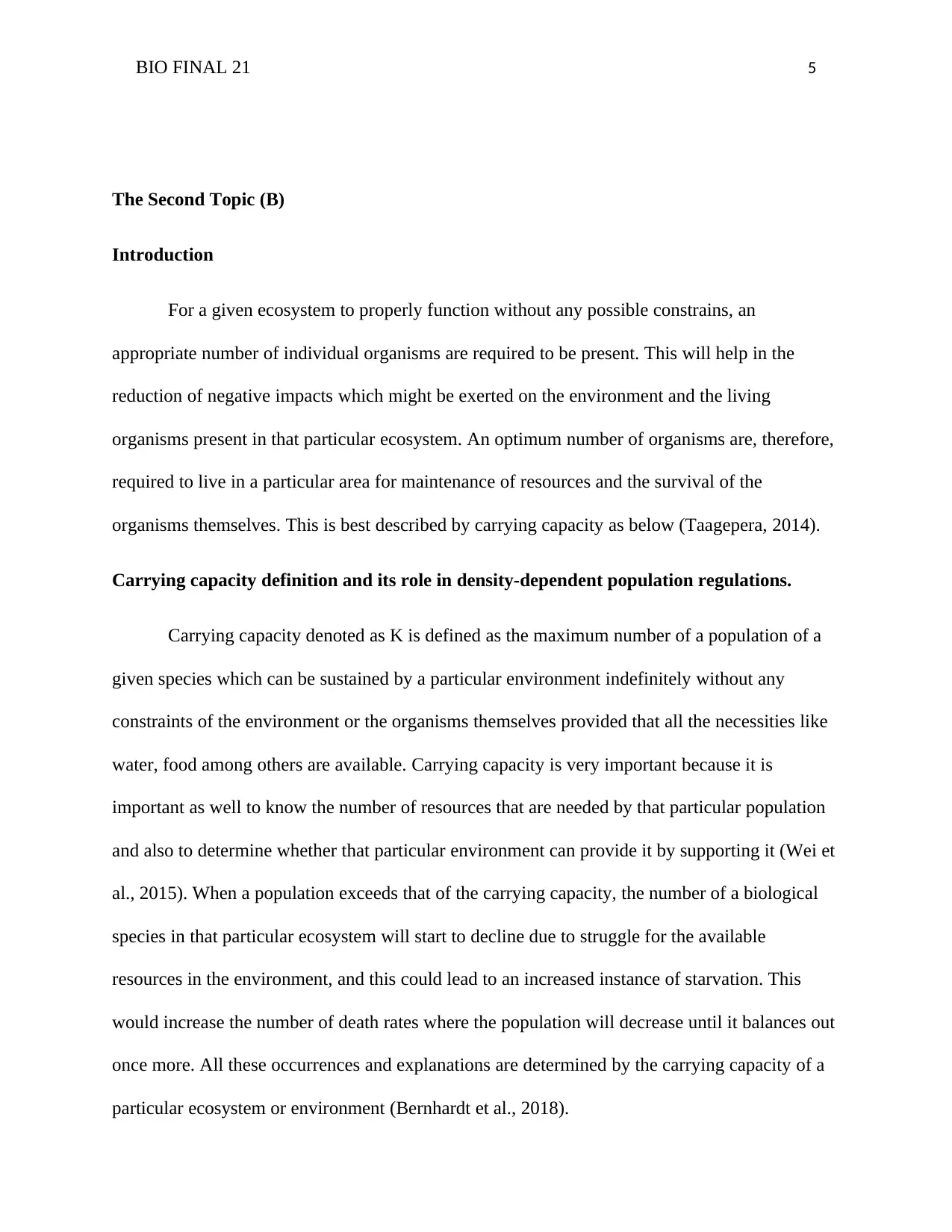
BIO FINAL 21 5
The Second Topic (B)
Introduction
For a given ecosystem to properly function without any possible constrains, an
appropriate number of individual organisms are required to be present. This will help in the
reduction of negative impacts which might be exerted on the environment and the living
organisms present in that particular ecosystem. An optimum number of organisms are, therefore,
required to live in a particular area for maintenance of resources and the survival of the
organisms themselves. This is best described by carrying capacity as below (Taagepera, 2014).
Carrying capacity definition and its role in density-dependent population regulations.
Carrying capacity denoted as K is defined as the maximum number of a population of a
given species which can be sustained by a particular environment indefinitely without any
constraints of the environment or the organisms themselves provided that all the necessities like
water, food among others are available. Carrying capacity is very important because it is
important as well to know the number of resources that are needed by that particular population
and also to determine whether that particular environment can provide it by supporting it (Wei et
al., 2015). When a population exceeds that of the carrying capacity, the number of a biological
species in that particular ecosystem will start to decline due to struggle for the available
resources in the environment, and this could lead to an increased instance of starvation. This
would increase the number of death rates where the population will decrease until it balances out
once more. All these occurrences and explanations are determined by the carrying capacity of a
particular ecosystem or environment (Bernhardt et al., 2018).
The Second Topic (B)
Introduction
For a given ecosystem to properly function without any possible constrains, an
appropriate number of individual organisms are required to be present. This will help in the
reduction of negative impacts which might be exerted on the environment and the living
organisms present in that particular ecosystem. An optimum number of organisms are, therefore,
required to live in a particular area for maintenance of resources and the survival of the
organisms themselves. This is best described by carrying capacity as below (Taagepera, 2014).
Carrying capacity definition and its role in density-dependent population regulations.
Carrying capacity denoted as K is defined as the maximum number of a population of a
given species which can be sustained by a particular environment indefinitely without any
constraints of the environment or the organisms themselves provided that all the necessities like
water, food among others are available. Carrying capacity is very important because it is
important as well to know the number of resources that are needed by that particular population
and also to determine whether that particular environment can provide it by supporting it (Wei et
al., 2015). When a population exceeds that of the carrying capacity, the number of a biological
species in that particular ecosystem will start to decline due to struggle for the available
resources in the environment, and this could lead to an increased instance of starvation. This
would increase the number of death rates where the population will decrease until it balances out
once more. All these occurrences and explanations are determined by the carrying capacity of a
particular ecosystem or environment (Bernhardt et al., 2018).
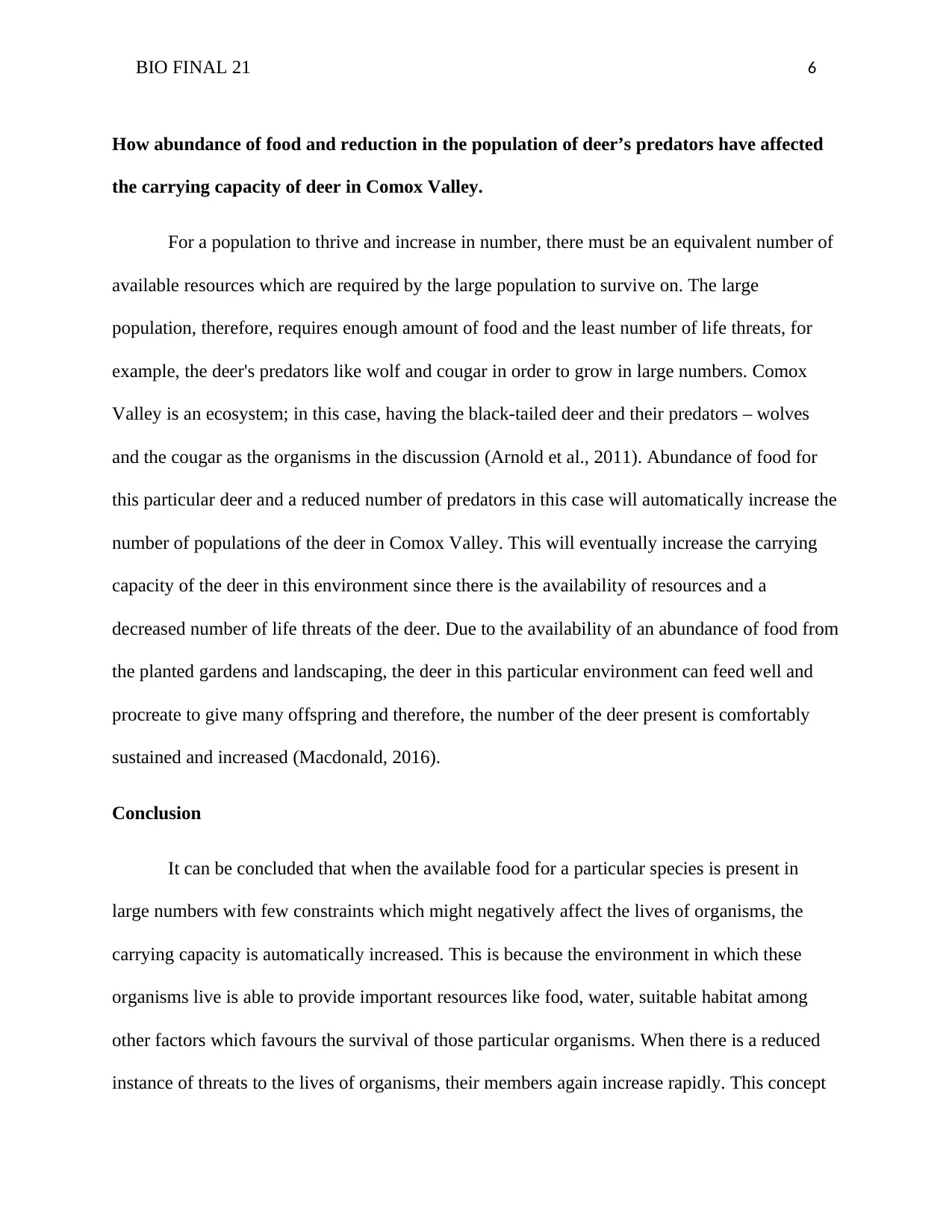
BIO FINAL 21 6
How abundance of food and reduction in the population of deer’s predators have affected
the carrying capacity of deer in Comox Valley.
For a population to thrive and increase in number, there must be an equivalent number of
available resources which are required by the large population to survive on. The large
population, therefore, requires enough amount of food and the least number of life threats, for
example, the deer's predators like wolf and cougar in order to grow in large numbers. Comox
Valley is an ecosystem; in this case, having the black-tailed deer and their predators – wolves
and the cougar as the organisms in the discussion (Arnold et al., 2011). Abundance of food for
this particular deer and a reduced number of predators in this case will automatically increase the
number of populations of the deer in Comox Valley. This will eventually increase the carrying
capacity of the deer in this environment since there is the availability of resources and a
decreased number of life threats of the deer. Due to the availability of an abundance of food from
the planted gardens and landscaping, the deer in this particular environment can feed well and
procreate to give many offspring and therefore, the number of the deer present is comfortably
sustained and increased (Macdonald, 2016).
Conclusion
It can be concluded that when the available food for a particular species is present in
large numbers with few constraints which might negatively affect the lives of organisms, the
carrying capacity is automatically increased. This is because the environment in which these
organisms live is able to provide important resources like food, water, suitable habitat among
other factors which favours the survival of those particular organisms. When there is a reduced
instance of threats to the lives of organisms, their members again increase rapidly. This concept
How abundance of food and reduction in the population of deer’s predators have affected
the carrying capacity of deer in Comox Valley.
For a population to thrive and increase in number, there must be an equivalent number of
available resources which are required by the large population to survive on. The large
population, therefore, requires enough amount of food and the least number of life threats, for
example, the deer's predators like wolf and cougar in order to grow in large numbers. Comox
Valley is an ecosystem; in this case, having the black-tailed deer and their predators – wolves
and the cougar as the organisms in the discussion (Arnold et al., 2011). Abundance of food for
this particular deer and a reduced number of predators in this case will automatically increase the
number of populations of the deer in Comox Valley. This will eventually increase the carrying
capacity of the deer in this environment since there is the availability of resources and a
decreased number of life threats of the deer. Due to the availability of an abundance of food from
the planted gardens and landscaping, the deer in this particular environment can feed well and
procreate to give many offspring and therefore, the number of the deer present is comfortably
sustained and increased (Macdonald, 2016).
Conclusion
It can be concluded that when the available food for a particular species is present in
large numbers with few constraints which might negatively affect the lives of organisms, the
carrying capacity is automatically increased. This is because the environment in which these
organisms live is able to provide important resources like food, water, suitable habitat among
other factors which favours the survival of those particular organisms. When there is a reduced
instance of threats to the lives of organisms, their members again increase rapidly. This concept
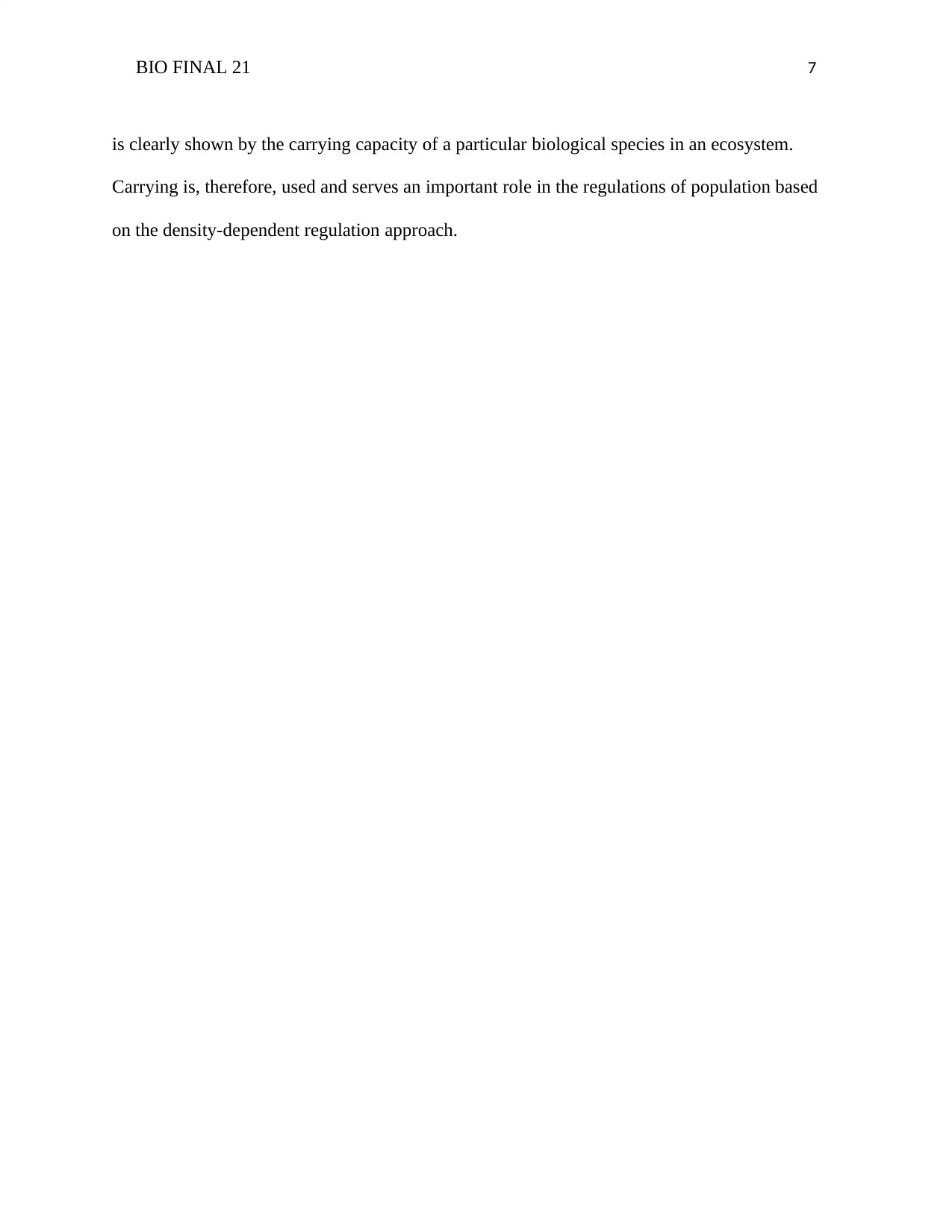
BIO FINAL 21 7
is clearly shown by the carrying capacity of a particular biological species in an ecosystem.
Carrying is, therefore, used and serves an important role in the regulations of population based
on the density-dependent regulation approach.
is clearly shown by the carrying capacity of a particular biological species in an ecosystem.
Carrying is, therefore, used and serves an important role in the regulations of population based
on the density-dependent regulation approach.
Paraphrase This Document
Need a fresh take? Get an instant paraphrase of this document with our AI Paraphraser
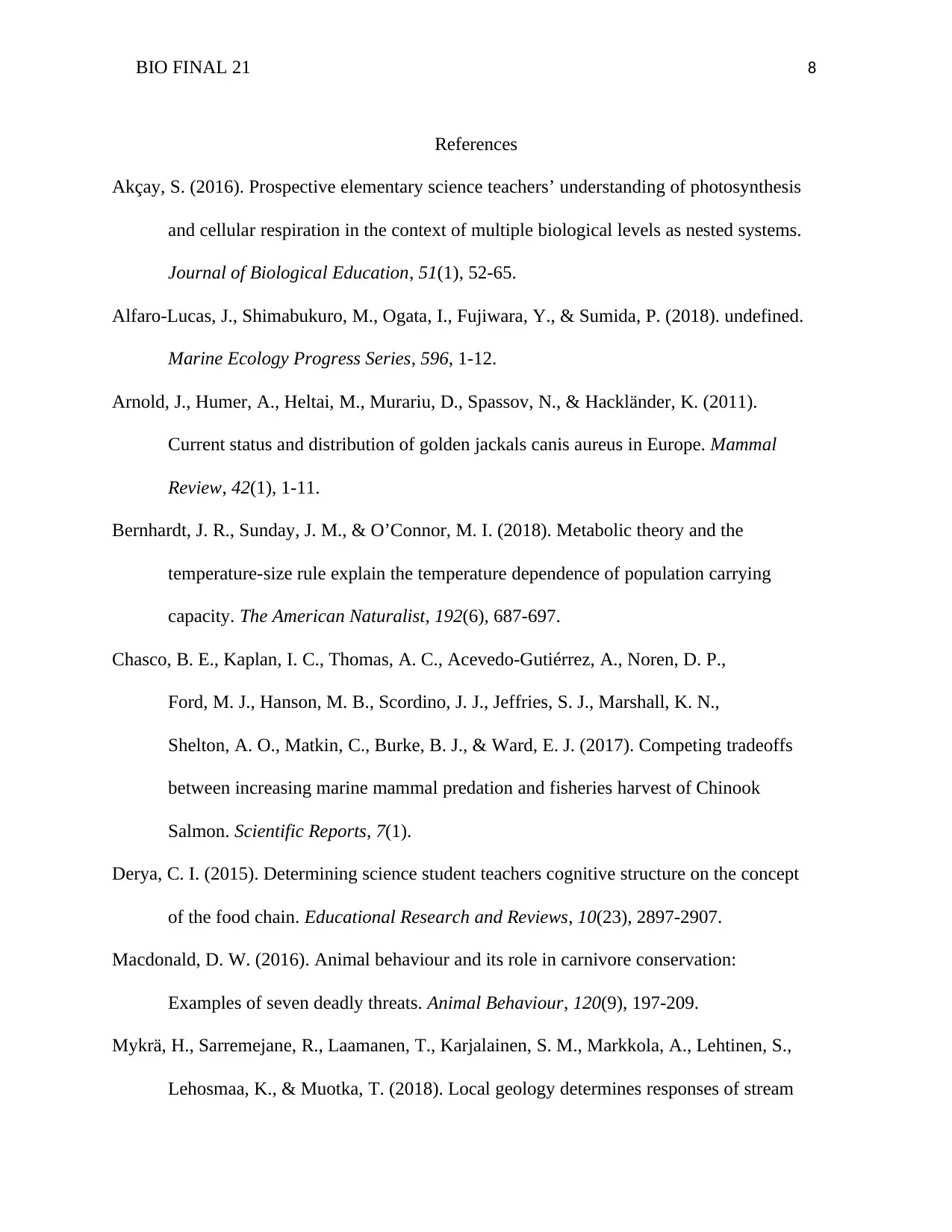
BIO FINAL 21 8
References
Akçay, S. (2016). Prospective elementary science teachers’ understanding of photosynthesis
and cellular respiration in the context of multiple biological levels as nested systems.
Journal of Biological Education, 51(1), 52-65.
Alfaro-Lucas, J., Shimabukuro, M., Ogata, I., Fujiwara, Y., & Sumida, P. (2018). undefined.
Marine Ecology Progress Series, 596, 1-12.
Arnold, J., Humer, A., Heltai, M., Murariu, D., Spassov, N., & Hackländer, K. (2011).
Current status and distribution of golden jackals canis aureus in Europe. Mammal
Review, 42(1), 1-11.
Bernhardt, J. R., Sunday, J. M., & O’Connor, M. I. (2018). Metabolic theory and the
temperature-size rule explain the temperature dependence of population carrying
capacity. The American Naturalist, 192(6), 687-697.
Chasco, B. E., Kaplan, I. C., Thomas, A. C., Acevedo-Gutiérrez, A., Noren, D. P.,
Ford, M. J., Hanson, M. B., Scordino, J. J., Jeffries, S. J., Marshall, K. N.,
Shelton, A. O., Matkin, C., Burke, B. J., & Ward, E. J. (2017). Competing tradeoffs
between increasing marine mammal predation and fisheries harvest of Chinook
Salmon. Scientific Reports, 7(1).
Derya, C. I. (2015). Determining science student teachers cognitive structure on the concept
of the food chain. Educational Research and Reviews, 10(23), 2897-2907.
Macdonald, D. W. (2016). Animal behaviour and its role in carnivore conservation:
Examples of seven deadly threats. Animal Behaviour, 120(9), 197-209.
Mykrä, H., Sarremejane, R., Laamanen, T., Karjalainen, S. M., Markkola, A., Lehtinen, S.,
Lehosmaa, K., & Muotka, T. (2018). Local geology determines responses of stream
References
Akçay, S. (2016). Prospective elementary science teachers’ understanding of photosynthesis
and cellular respiration in the context of multiple biological levels as nested systems.
Journal of Biological Education, 51(1), 52-65.
Alfaro-Lucas, J., Shimabukuro, M., Ogata, I., Fujiwara, Y., & Sumida, P. (2018). undefined.
Marine Ecology Progress Series, 596, 1-12.
Arnold, J., Humer, A., Heltai, M., Murariu, D., Spassov, N., & Hackländer, K. (2011).
Current status and distribution of golden jackals canis aureus in Europe. Mammal
Review, 42(1), 1-11.
Bernhardt, J. R., Sunday, J. M., & O’Connor, M. I. (2018). Metabolic theory and the
temperature-size rule explain the temperature dependence of population carrying
capacity. The American Naturalist, 192(6), 687-697.
Chasco, B. E., Kaplan, I. C., Thomas, A. C., Acevedo-Gutiérrez, A., Noren, D. P.,
Ford, M. J., Hanson, M. B., Scordino, J. J., Jeffries, S. J., Marshall, K. N.,
Shelton, A. O., Matkin, C., Burke, B. J., & Ward, E. J. (2017). Competing tradeoffs
between increasing marine mammal predation and fisheries harvest of Chinook
Salmon. Scientific Reports, 7(1).
Derya, C. I. (2015). Determining science student teachers cognitive structure on the concept
of the food chain. Educational Research and Reviews, 10(23), 2897-2907.
Macdonald, D. W. (2016). Animal behaviour and its role in carnivore conservation:
Examples of seven deadly threats. Animal Behaviour, 120(9), 197-209.
Mykrä, H., Sarremejane, R., Laamanen, T., Karjalainen, S. M., Markkola, A., Lehtinen, S.,
Lehosmaa, K., & Muotka, T. (2018). Local geology determines responses of stream
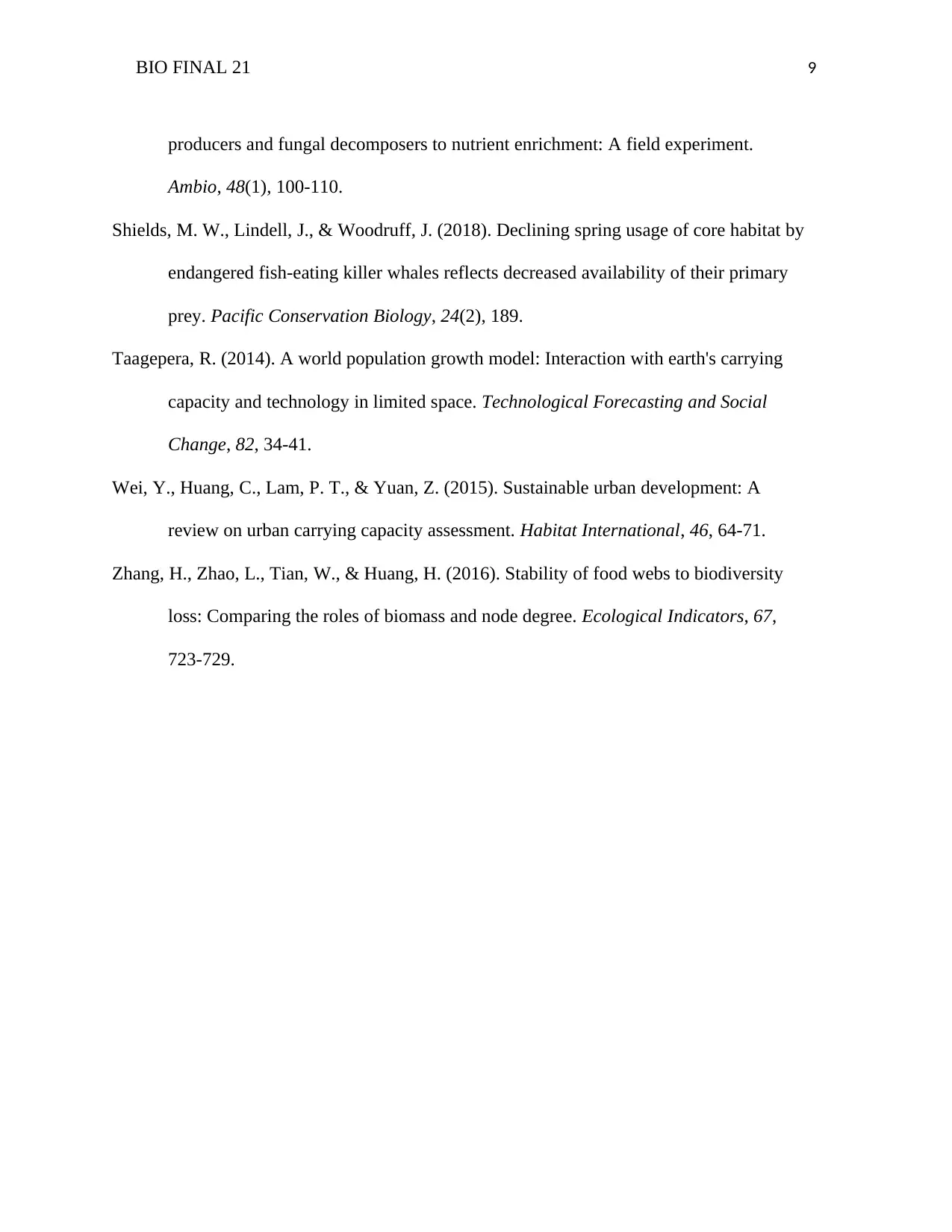
BIO FINAL 21 9
producers and fungal decomposers to nutrient enrichment: A field experiment.
Ambio, 48(1), 100-110.
Shields, M. W., Lindell, J., & Woodruff, J. (2018). Declining spring usage of core habitat by
endangered fish-eating killer whales reflects decreased availability of their primary
prey. Pacific Conservation Biology, 24(2), 189.
Taagepera, R. (2014). A world population growth model: Interaction with earth's carrying
capacity and technology in limited space. Technological Forecasting and Social
Change, 82, 34-41.
Wei, Y., Huang, C., Lam, P. T., & Yuan, Z. (2015). Sustainable urban development: A
review on urban carrying capacity assessment. Habitat International, 46, 64-71.
Zhang, H., Zhao, L., Tian, W., & Huang, H. (2016). Stability of food webs to biodiversity
loss: Comparing the roles of biomass and node degree. Ecological Indicators, 67,
723-729.
producers and fungal decomposers to nutrient enrichment: A field experiment.
Ambio, 48(1), 100-110.
Shields, M. W., Lindell, J., & Woodruff, J. (2018). Declining spring usage of core habitat by
endangered fish-eating killer whales reflects decreased availability of their primary
prey. Pacific Conservation Biology, 24(2), 189.
Taagepera, R. (2014). A world population growth model: Interaction with earth's carrying
capacity and technology in limited space. Technological Forecasting and Social
Change, 82, 34-41.
Wei, Y., Huang, C., Lam, P. T., & Yuan, Z. (2015). Sustainable urban development: A
review on urban carrying capacity assessment. Habitat International, 46, 64-71.
Zhang, H., Zhao, L., Tian, W., & Huang, H. (2016). Stability of food webs to biodiversity
loss: Comparing the roles of biomass and node degree. Ecological Indicators, 67,
723-729.
1 out of 9
Your All-in-One AI-Powered Toolkit for Academic Success.
+13062052269
info@desklib.com
Available 24*7 on WhatsApp / Email
![[object Object]](/_next/static/media/star-bottom.7253800d.svg)
Unlock your academic potential
© 2024 | Zucol Services PVT LTD | All rights reserved.


